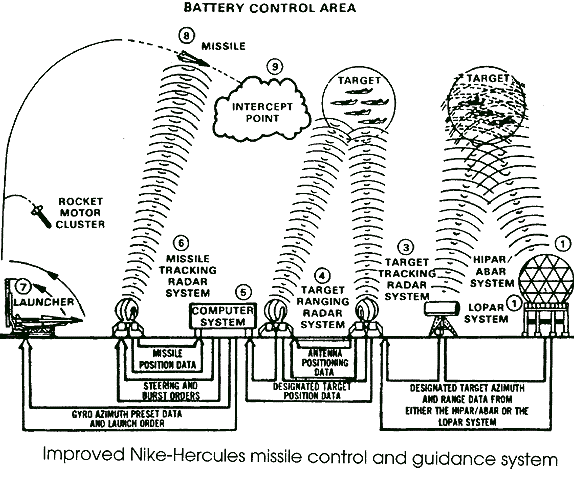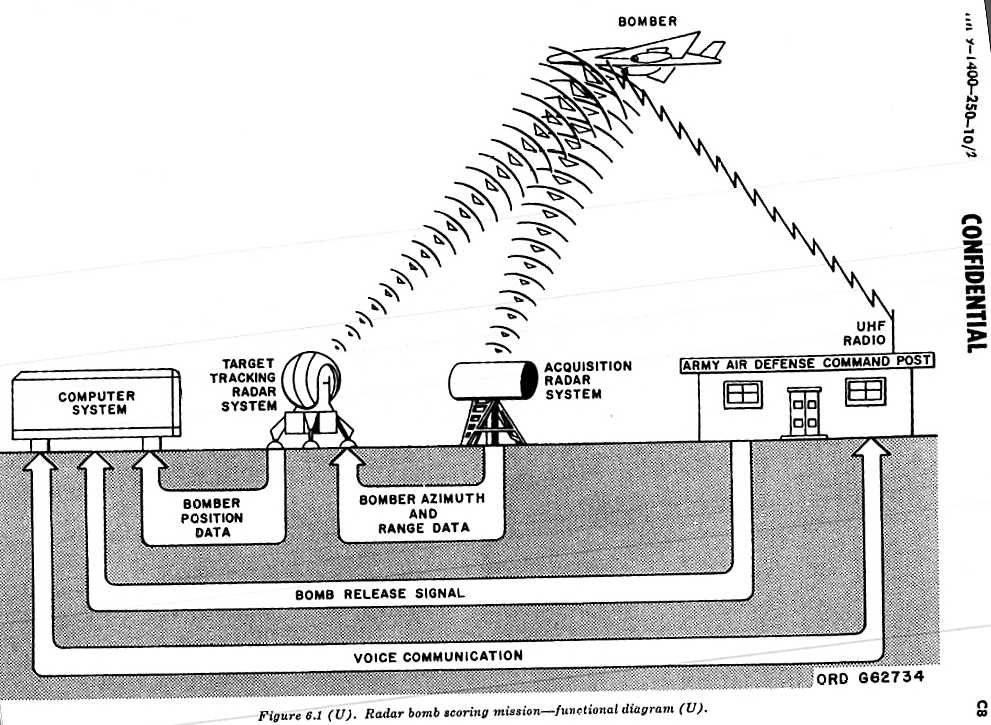Return to Home,
Goto Next Section
The Nike system was originally designed for the
Surface-to-Air mission - destroying high flying aircraft -
similar to the World War II problem, but made much more
difficult with the introduction of:
The earliest Nike system (Ajax), using conventional explosives could
quite well destroy fast, high flying jets carrying conventional or nuclear bombs.
The larger Nike Hercules superceeded the Ajax with:
The Hercules (Surface-to-Surface Mision) could also be set to attack fixed or slow
ground targets with a nuclear warhead at a range of 100 miles.
( ? A variant in Korea could use conventional warheads ? )
The following is taken from
TM 9-1400-250-10/2 - Overall System Description
- pages 17 - 21
- the Surface-to-Air Mision
11 (C). Surface-to-Air Mision
After the
target has been detected and identified, the
target range and azimuth is electrically designated
to the target-tracking radar (TTR) system.
When the TTR azimuth operator receives an
indication of target designation, he will
immediately initiate action (acquire) to cause the TTR
to electrically position itself to the designated
range and azimuth.
While the TTR is tracking
the target, target-present position data
(elevation, azimuth, and range) is continuously
supplied to a computer system. The target ranging
radar (TRR) is slaved to the TTR in elevation
and azimuth. During enemy-countermeasure
activities, target-range information is provided
to the computer by the TRR and elevation and
azimuth information is provided by the TTR.
From the target position data, the computer
system continuously calculates a predicted intercept
point. The azimuth of the predicted intercept
point is sent as gyro azimuth preset data by the
computer system to the previously designated
missile. This data orients a gyro in the missile
so that, after launch, the missile automatically
rolls to the correct attitude with respect to the
predicted intercept point.
A missile tracking
radar system is electronically locked on the
designated missile while the missile is still on a
launcher so that, alter launch, this radar
system can supply uninterrupted missile position
data to the computer system. The computer
system continuously supplies data to two plotting
boards which enable the battery control
officer to determine the optimum time to launch
the missile.
b. When the missile is launched, a rocket
motor cluster provides the initial thrust and
separates from the missile in approximately 3.8
seconds at approximately 3,500 feet. The computer
system continuously calculates a proper
missile trajectory, as determined by the target
and missile position data being supplied by the
tracking radar systems.
The computer system
then sends appropriate steering orders to the
missile by way of the missile tracking radar
system. At a predetermined time before intercept,
the computer system automatically sends
a burst order by way of the missile tracking
radar system.
The burst order causes the missile
warhead to detonate within a lethal radius
of the target. Detonation of the missile warhead
shortly before intercept provides the most effective
burst coverage.
12 (Deleted).
13 (C). Surface-to-Surface Mission
This is a section of the manual TM 9-1430-253-12/4
The range, azimuth,
and elevation coordinates of the target
are calculated and manually set into the target
tracking radar system. Therefore, the target
tracking radar system supplies constant target
position data to the computer system.
The
function of the computer system is similar to
that described in paragraph 11 [above] for a normal
surface-to air mission except that missile
trajectory data is manually set into the computer
system causing the missile to be guided toward
a point in space above the desired point of
impact. At a predetermined time, this point in
space is removed causing the computer to issue
a dive order to the missile.
The missile then
approaches the ground target in a
near-perpenicular trajectory. As the missile approaches
the ground, the computer system sends a burst
order to the missile. However, due to special
preparation of the missile for a surface-to-surface
mission, the burst order does not
cause the missile warhead to detonate. Instead,
the burst order disables the missile
fail-safe mechanism and causes guidance cutoff
by disabling the missile receiver.
The burst
order also arms a preset barometric fuze in the
missile warhead, and rolls the missile 180 degrees
to compensate for flight biases inherent
in the missile. The missile then follows a vertical
trajectory until the barometric fuze causes
the nuclear missile warhead to detonate at a
predetermined altitude above the target.
- Jet engines - aircraft flew higher and faster
- Nuclear weapons - one aircraft with one bomb can destroy a city.
- longer range ( 100 miles vs 25 for the Ajax )
- ability carry to a nuclear warhead to destroy multiple aircraft
- greater range resolution to reduce confusion with close flying
aircraft
- the Surface-to-Surface Mision
- the Radar Bomb Scoring Mission

a. In a surface-to-air mission (fig. 5)
the
acquisition radar operator will use one of the
acquisition radar systems (LOPAR or HIPAR/AAR)
and the associated selective identification
feature/identification friend or foe (SIF/IFF)
system to detect and identify targets.

In a surface-to-surface mission (fig. 7),
the
acquisition radar systems are not used because
the target position is known.
